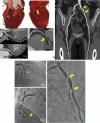Single injection protocol for coronary and lower extremity CT angiographies in patients suspected for peripheral arterial disease
- PMID: 27861382
- PMCID: PMC5120939
- DOI: 10.1097/MD.0000000000005410
Single injection protocol for coronary and lower extremity CT angiographies in patients suspected for peripheral arterial disease
Abstract
To evaluate the feasibility of a single injection protocol for coronary CT angiography (CTA) and lower extremity CTA in patients suspected for peripheral arterial disease (PAD).This prospective observational study included a total of 103 patients who showed an ankle brachial index ≤0.9 and underwent the single injection protocol for coronary and lower extremity CTA. All CTAs used iodinated contrast (weight × 0.06 mL/s × 20 seconds). A prospective Electrocardiogram (ECG)-gated coronary CTA was performed, followed by helical lower extremity CTA beginning 9 seconds after coronary CTA. Using catheter angiography as reference standard, diagnostic ability of CTA was evaluated.The mean total volume of iodinated contrast used was 70 ± 14 mL. Contrast opacification in the superficial femoral artery was adequate (408 ± 97 Hounsfield Units [HU]) and PAD was detected in 72.8% (75/103). The estimated radiation doses for lower extremity and coronary CTA were 3.6 ± 1.2 and 5.5 ± 4.5 mSv. A significant coronary stenosis was detected in 47 patients (45.6%). Coronary CT image quality was recorded as excellent in 86.4%, acceptable in 11.7%, and unacceptable for 1.9%. Contrast opacification within the superficial femoral artery was adequate in all cases while 27.2% needed an additional scan below the calf to capture the contrast bolus arrival in the smaller lower extremity vessels. Segment based sensitivity, specificity, positive, and negative predictive values were 57.9%, 97.9%, 73.8%, and 95.9% for the coronary CTA, and 63.4%, 91.5%, 76.3%, and 85.3% for peripheral CTA.A single injection protocol for coronary CTA and lower extremity CTA is feasible with a relatively small volume of iodinated contrast.
Conflict of interest statement
The authors report no conflicts of interest.
Figures


Similar articles
-
CT angiography of the lower extremity and coronary arteries using 256-section CT: a preliminary study.Clin Radiol. 2015 Nov;70(11):1281-8. doi: 10.1016/j.crad.2015.07.003. Epub 2015 Aug 12. Clin Radiol. 2015. PMID: 26275584
-
Coronary CT angiography with 80 kV tube voltage and low iodine concentration contrast agent in patients with low body weight.J Cardiovasc Comput Tomogr. 2016 Jul-Aug;10(4):322-6. doi: 10.1016/j.jcct.2016.06.003. Epub 2016 Jun 15. J Cardiovasc Comput Tomogr. 2016. PMID: 27357327
-
CT Angiography in the Lower Extremity Peripheral Artery Disease Feasibility of an Ultra-Low Volume Contrast Media Protocol.Cardiovasc Intervent Radiol. 2018 Nov;41(11):1751-1764. doi: 10.1007/s00270-018-1979-z. Epub 2018 May 22. Cardiovasc Intervent Radiol. 2018. PMID: 29789875 Free PMC article.
-
Multidetector Computed Tomography Angiography (MD-CTA) of Coronary Artery Bypass Grafts - Update 2017.Rofo. 2018 Mar;190(3):237-249. doi: 10.1055/s-0043-120528. Epub 2017 Nov 3. Rofo. 2018. PMID: 29100255 Review. English.
-
Head-to-head comparison of prospectively triggered vs retrospectively gated coronary computed tomography angiography: Meta-analysis of diagnostic accuracy, image quality, and radiation dose.Am Heart J. 2013 Feb;165(2):154-63.e3. doi: 10.1016/j.ahj.2012.10.026. Epub 2012 Nov 26. Am Heart J. 2013. PMID: 23351817 Review.
References
-
- Grundy SM, Pasternak R, Greenland P, et al. Assessment of cardiovascular risk by use of multiple-risk-factor assessment. Circulation 1999; 100:1481–1492. - PubMed
-
- Her K, Choi C, Park Y, et al. Concomitant peripheral artery disease and asymptomatic coronary artery disease. Ann Vasc Surg 2008; 22:649–656. - PubMed
-
- Duran NE, Duran I, Gurel E, et al. Coronary artery disease in patients with peripheral artery disease. Heart Lung 2010; 39:116–120. - PubMed
-
- Moussa ID, Jaff MR, Mehran R, et al. Prevalence and prediction of previously unrecognized peripheral arterial disease. Catheter Cardiovasc Interven 2009; 73:719–724. - PubMed
Publication types
MeSH terms
Substances
LinkOut - more resources
Full Text Sources
Other Literature Sources
Medical

